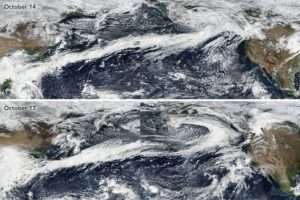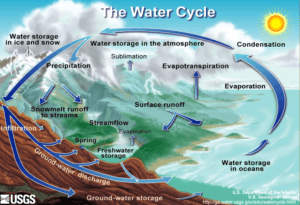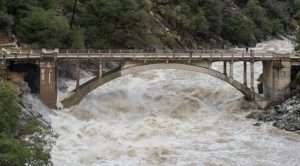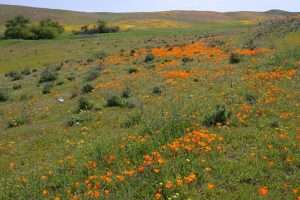 In recent weeks, the West Coast has been hit with multiple atmospheric rivers and bomb cyclones, causing massive storms, torrential rain, and the floods and landslides that often result. This includes areas of California that have been hit incredibly hard by drought over the past several years.
In recent weeks, the West Coast has been hit with multiple atmospheric rivers and bomb cyclones, causing massive storms, torrential rain, and the floods and landslides that often result. This includes areas of California that have been hit incredibly hard by drought over the past several years.
I’ve seen a lot of people elated that the snowpack on California’s mountains has been increasing at record speeds. And reservoirs are the highest they’ve been in years. These are certainly excellent silver linings amid the tragedy and loss of life brought by flooding, and in the short term they’ll bring some much-needed relief. Unfortunately, they aren’t going to bring California–and the rest of the West–out of the current drought.
A Little Bit of Hydrology
You may have learned in school that the basic water cycle consists of evaporation, condensation, and precipitation. Which is all true, of course. But there’s a lot more to hydrology than that.
Hydrology can be defined as how water is captured, held, and safely released by the land. For instance, here in the Pacific Northwest (west of the Cascades, anyway) we’re accustomed to a long rainy season that starts in fall, goes all the way through winter, and in some years persists almost to summer. There are plenty of rainy days–not the heavy downpours we’ve been seeing, but a mix of steady rain, drizzles, and mists.

Once the rain hits the ground, the soil soaks it up like a sponge. Soil is made of a mix of eroded bedrock and decayed/decaying organic matter; the more organic matter in the soil, and the thicker the soil, the more water it can hold. Some of the water trickles through the soil to be released into streams and rivers above ground. The inherent sponginess of our soil slows the water down enough that some of it also sifts down into groundwater stores.
It’s the same thing in drier areas, too. Arid zones like the Northwest east of the Cascades, or large portions of central and southern California, don’t typically receive as much precipitation, and the soil doesn’t have as much absorbency. But the basic hydrological cycle is the same, and in a normal rain year groundwater reserves are replenished along with the snowpack and reservoirs.
Too Much of a Good Thing
The problem is that the atmospheric rivers and other massive storms that have been hitting the West Coast more frequently in recent years are too much for our natural hydrological system to handle. It’s like the difference between watering a garden with a sprinkling can versus a high-powered nozzle at full blast. Too much water falls at once; the soil becomes saturated more quickly, at which point it can no longer absorb any more rain.
Because more water is falling in a shorter period of time, the excess rain flows off the surface of the ground, no longer slowed by soil. This leads to increased flooding, and the super-saturated soil is more likely to create massive landslides. Although the reservoirs are able to capture some of the rain, there’s a lot that’s simply escaping downstream.
 The soil is still sending some water down into the groundwater system. But the precipitation is concentrated into smaller periods of time during violent storms instead of stretched out over weeks of intermittent to steady rain. That means that by the time the soil has offloaded its excess water, the storm has passed and another dry period begins. Ultimately less precipitation is making it down through the soil into groundwater stores.
The soil is still sending some water down into the groundwater system. But the precipitation is concentrated into smaller periods of time during violent storms instead of stretched out over weeks of intermittent to steady rain. That means that by the time the soil has offloaded its excess water, the storm has passed and another dry period begins. Ultimately less precipitation is making it down through the soil into groundwater stores.
One storm won’t refill groundwater, either; often these aquifers and basins take years or even decades to fully recharge. Keep in mind that groundwater across western half of the United States has been used at a much higher rate than it replenishes for many decades due to the demand for water for agriculture, industry, and a rapidly growing population. These demands aren’t going away, either; they’ll continue sucking down water until everything runs dry.
And the larger snowpacks? Unfortunately, the hotter summers mean that they will still be melting faster than normal. The extra depth means that we’ve got more padding than we did a year ago, but it isn’t going to fix everything; it just buys us a little more time.
Climate Change is the Culprit
Both the drought and atmospheric rivers are symptoms of a larger problem: climate change. The higher average global temperatures are wreaking havoc on weather patterns, causing greater and more frequent extremes.
A lot of this is because warmer air can hold more humidity, which has a direct effect on how much precipitation is dropped by storms. The warming of both the atmosphere and the oceans leads directly to more powerful storms. Conversely, because precipitation events are concentrated into shorter periods of time, coupled with higher temperatures overall, we’re seeing longer and more extreme droughts worldwide.
All of this doesn’t mean you can’t be happy about the immediate relief given by higher reservoir levels and snowpack increases. After all, I’m pretty happy about the fact that some lives will certainly be saved because of it. This is legitimately a good turn of events, even if it came out of something awful. And who knows? Maybe there will be other little silver linings along the way; after all, rain sometimes brings super blooms of wildflowers.
My suggested takeaway from this article is: be balanced in your approach to climate news. Yes, we need to stay as motivated and engaged as we realistically can in the fight for a better climate future, and not let the momentary successes lull us into thinking the battle is over. But it’s really important for us to celebrate the wins we do get. Allowing ourselves to focus on good news can help increase emotional resilience and provide a much-needed break from doom and gloom headlines. In short: you aren’t ignoring the problems if you give yourself some time to think about something else, and in fact changing your mental channel for a while is a crucial act of self-care.
And then, when you feel ready to engage again, just remember that not all is lost, and there’s still plenty left to keep fighting for.

